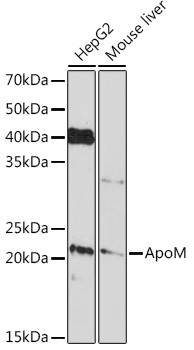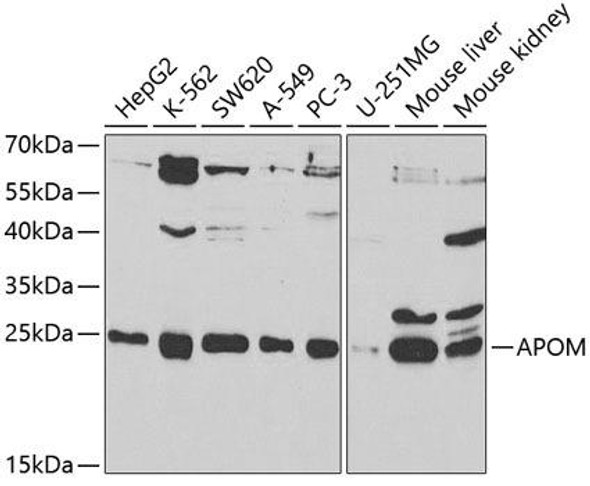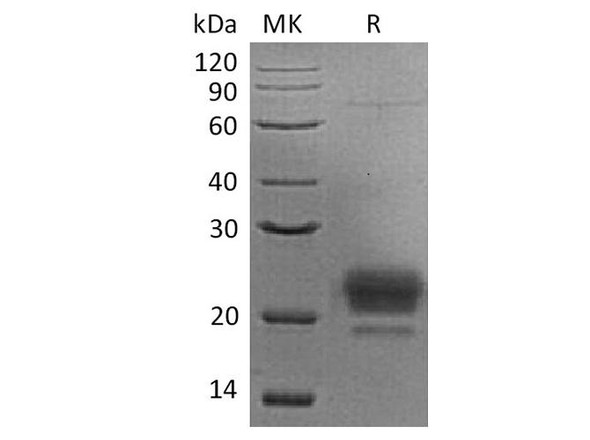Cell Biology Antibodies 17
Anti-ApoM Antibody (CAB5144)
- SKU:
- CAB5144
- Product Type:
- Antibody
- Reactivity:
- Human
- Reactivity:
- Mouse
- Host Species:
- Rabbit
- Isotype:
- IgG
- Research Area:
- Cell Biology
Description
| Antibody Name: | Anti-ApoM Antibody |
| Antibody SKU: | CAB5144 |
| Antibody Size: | 20uL, 50uL, 100uL |
| Application: | WB IF |
| Reactivity: | Human, Mouse |
| Host Species: | Rabbit |
| Immunogen: | A synthesized peptide derived from human ApoM |
| Application: | WB IF |
| Recommended Dilution: | WB 1:500 - 1:2000 IF 1:50 - 1:200 |
| Reactivity: | Human, Mouse |
| Positive Samples: | HepG2, Mouse liver |
| Immunogen: | A synthesized peptide derived from human ApoM |
| Purification Method: | Affinity purification |
| Storage Buffer: | Store at -20'C. Avoid freeze / thaw cycles. Buffer: PBS with 0.02% sodium azide, 0.05% BSA, 50% glycerol, pH7.3. |
| Isotype: | IgG |
| Sequence: | Email for sequence |
| Gene ID: | 55937 |
| Uniprot: | O95445 |
| Cellular Location: | |
| Calculated MW: | 25kDa |
| Observed MW: | 21KDa |
| Synonyms: | G3a, HSPC336, NG20, apo-M |
| Background: | The protein encoded by this gene is an apolipoprotein and member of the lipocalin protein family. It is found associated with high density lipoproteins and to a lesser extent with low density lipoproteins and triglyceride-rich lipoproteins. The encoded protein is secreted through the plasma membrane but remains membrane-bound, where it is involved in lipid transport. Alternate splicing results in both coding and non-coding variants of this gene. [provided by RefSeq, Jan 2012] |
| UniProt Protein Function: | APOM: Probably involved in lipid transport. Can bind sphingosine-1-phosphate, myristic acid, palmitic acid and stearic acid, retinol, all-trans-retinoic acid and 9-cis-retinoic acid. Plasma protein. Expressed in liver and kidney. Belongs to the calycin superfamily. Lipocalin family. Highly divergent. |
| UniProt Protein Details: | Protein type:Secreted, signal peptide; Secreted Chromosomal Location of Human Ortholog: 6p21.33 Cellular Component: integral to plasma membrane Molecular Function:antioxidant activity; lipid transporter activity; phospholipid binding Biological Process: cholesterol homeostasis; reverse cholesterol transport; response to glucose stimulus; cholesterol efflux; lipoprotein metabolic process |
| NCBI Summary: | The protein encoded by this gene is an apolipoprotein and member of the lipocalin protein family. It is found associated with high density lipoproteins and to a lesser extent with low density lipoproteins and triglyceride-rich lipoproteins. The encoded protein is secreted through the plasma membrane but remains membrane-bound, where it is involved in lipid transport. Alternate splicing results in both coding and non-coding variants of this gene. [provided by RefSeq, Jan 2012] |
| UniProt Code: | O95445 |
| NCBI GenInfo Identifier: | 17370872 |
| NCBI Gene ID: | 55937 |
| NCBI Accession: | O95445.2 |
| UniProt Secondary Accession: | O95445,Q5SRP4, Q9P046, Q9UMP6, B0UX98, |
| UniProt Related Accession: | O95445 |
| Molecular Weight: | 188 |
| NCBI Full Name: | Apolipoprotein M |
| NCBI Synonym Full Names: | apolipoprotein M |
| NCBI Official Symbol: | APOM |
| NCBI Official Synonym Symbols: | G3a; NG20; apo-M; HSPC336 |
| NCBI Protein Information: | apolipoprotein M; protein G3a; NG20-like protein; alternative name: G3a, NG20 |
| UniProt Protein Name: | Apolipoprotein M |
| UniProt Synonym Protein Names: | Protein G3a |
| Protein Family: | Apomucin |
| UniProt Gene Name: | APOM |
| UniProt Entry Name: | APOM_HUMAN |
View AllClose







